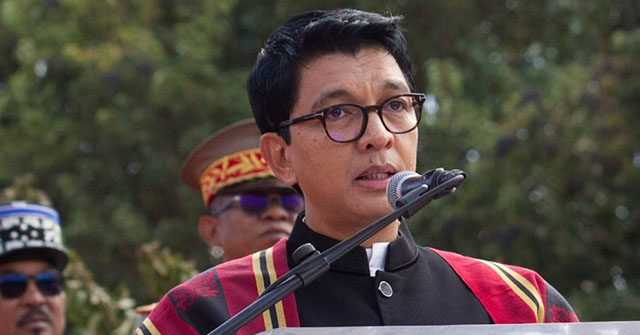Protests and strikes are escalating in Madagascar, where President Andry Rajoelina faces calls for his resignation over mismanagement, water shortages, and power cuts.
The protest movement appears to have grown even more energetic and determined after Rajoelina ordered harsh police crackdowns on demonstrators. The death toll from the crackdown stood at 22 as of Thursday, according to the United Nations.
The demonstrations began two weeks ago, driven by public anger over daily power outages and frequent water shortages. Madagascar is rich in mineral, agricultural, and maritime resources but much of the population lives in poverty, in part because the government is reluctant to develop its mineral resources due to environmental concerns.
Madagascar is frequently plagued by droughts, which are very bad news for a population that depends on subsistence farming. Rajoelina, a former disc jockey and mayor of the capital city of Antananarivo who came to power in a 2009 coup, was evidently astounded by the level of public anger over his government’s inability to provide reliable supplies of water, despite huge international investments in Madagascar’s infrastructure.
The public is equally frustrated by the lack of reliable electric power. Madagascar’s villages are frozen in the past, with human and animal labor more common than motos. Residents of Antananarivo literally live in the shadow of government failure, as the city boasts an expensive boondoggle of a sky tram system that usually lacks the electric power needed to run.
The people of Madagascar (known collectively as the “Malagasy”) rightly suspect corruption as a major reason for their national squalor. Public officials are incredibly corrupt, working with smugglers to furnish the islands fabled flora and fauna to black-market buyers and extracting constant bribes from legitimate businesses.
Anti-corruption activists described Madagascar as a “mafia state” and a “treasure island plundered by pirates” to The Economist on Tuesday, as foreign observers struggled to understand how the protest movement exploded so quickly.
Corruption and foolish socialist policies have drained the national treasury and left Madagascar unable to cope with setbacks such as drought and soil degradation from deforestation. The latest round of rolling blackouts in September were the spark that touched off decades of mounting frustration and despair. The more-or-less official slogan of the protests is “We Want to Live, Not Survive.”
The Madagascar protest has a heavy youth component, much like similar demonstrations in Indonesia, Nepal, and Morocco, leading some observers to describe Madagascar as part of a worldwide “Generation Z” movement. The group coordinating the protests calls itself “Gen Z Madagascar.”
The Malagasy protesters even borrowed the unusual symbol embraced by the Indonesian movement: a cartoon skull and crossbones wearing a straw hat, drawn from the popular Japanese manga and anime One Piece. The characters in One Piece are a band of merry young pirates standing up to a corrupt authoritarian government.
Young demonstrators in Madagascar have told reporters they feel a particular kinship to the youth movement in Nepal, where the spark that touched off the powder keg was a ban on social media, but a more durable source of public anger was the luxury lifestyle enjoyed by the children of rich and corrupt elites.
“We are going through the same things and it gave us the courage to rise up and demonstrate. We are demanding the complete overhaul of an entire system,” a young Malagasy protester told NPR on Thursday, addressing the relationship between the movements in Nepal and Madagascar.
President Rajoelina panicked as the protests grew, ordering a police crackdown so brutal that it caught the attention of the United Nations. The U.N. missions from Germany, France, the United Kingdom, Switzerland, Japan, South Korea, and the European Union issued a joint statement on Thursday urging all parties in Madagascar to “show restraint and reject all forms of violence.”
The government was particularly determined to keep the Gen Z protesters out of Democracy Square in the heart of Antananarivo, because it was the scene of the massive protests against the previous government that brought Rajoelina to power in 2009. Rajoelina appeared to lose that battle on Tuesday as the protesters finally made it to Democracy Square after two weeks of effort, only to be hit by a fusillade of tear gas and rubber bullets from police. Some 10,000 demonstrators battled with police across the streets of the capital on Tuesday, and thousands more marched in other cities.
Rajoelina, a relatively youthful leader himself at just 51 years of age, claims he understands the frustrations of the demonstrators.
“When the Malagasy people suffer, I want you to know that I feel that pain too, and I have not slept, day or night, in my efforts to find solutions and improve the situation,” he said on Monday.
The president sacked most of his government on Monday, but that only seems to have emboldened the protesters, who began calling for his resignation, along with a purge of corrupt legislators from the national parliament. They also want Rajoelina’s top financial backer, a businessman named Mamy Ravatomanga, put on trial for corruption.
The Malagasy political opposition mostly sat out the protests until Wednesday, when its various parties and representatives issued a rare joint statement endorsing the Gen Z movement and agreeing with its demand.
On Wednesday, the protesters called on trade unionists to join forces with them by declaring a general strike. Rajoelina pushed back against the calls for his resignation by claiming the protests are “based on rumors or misinformation,” and said he would not tolerate attempts to stage a “coup.”
Read the full article here



